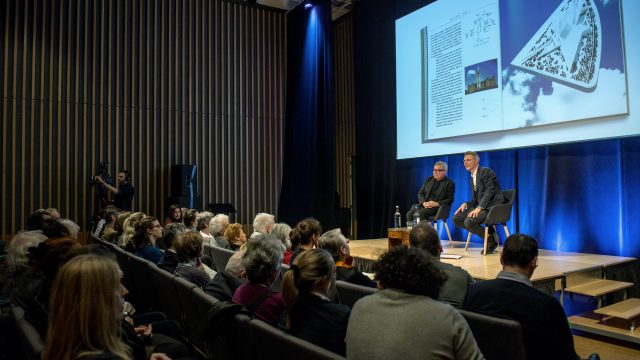Event Summary
“Without a story, a building becomes a commercial object – however beautiful it is”, internationally-renowned architect Daniel Libeskind told the audience at JW3 cultural centre in London on 4th March 2019, on the importance of narrative and storytelling within architecture.
Libeskind was interviewed live on the JW3 stage by Tim Marlow, the art historian and commentator on the contemporary cultural scene, who became the Royal Academy’s Director of Artistic Programmes in 2014.
Libeskind spoke liberally on how architecture, and art in general, should be accessible to all. “Anyone can pick up a brush and make a watercolour, anyone can pick up a pencil and do something with it”, he said. As such, Libeskind – who did not complete his first building until the age of 52 – views his career trajectory as something of a happy accident.
Born in Poland, Libeskind was the child of two Holocaust survivors and also lived in Israel, before moving to New York in his teens. As a child, he became a virtuoso on the accordion and this early exposure to music proved to be fundamental in his wider appreciation of the arts. “Even though I gave up music on an instrument, I never really gave it up”, he said.
“We don’t really appreciate that our sense of balance is not in the eye but in the ear”
Music has influenced many of Libeskind’s major projects – from Arnold Schoenberg’s unfinished opera “Moses and Aaron”, that helped to create the sense of “void” within the Jewish Museum in Berlin, to the gushing acoustics of the waterfall fountains Libeskind designed as part of the Ground Zero masterplan. “We don’t really appreciate that our sense of balance is not in the eye but in the ear”, he said.
Libeskind also revealed some of the other eclectic, sensory inspirations behind his most iconic buildings. For example, the Imperial War Museum North, Libeskind’s metallic masterpiece in Manchester, came to life after the architect threw a teapot out of the window in a plastic bag and inspected its broken pieces. Through this “momentary piece of madness” Libeskind came up with the idea of a globe in fragments, a metaphor for the world at war, that would form the basis for the museum’s grand design.
Libeskind’s metallic masterpiece in Manchester, came to life after the architect threw a teapot out of the window
For the redevelopment of Ground Zero in Lower Manhattan, Libeskind’s inspiration was even more personal. Seeing the slurry wall at the base of the site for the first time, which prevented the New York subway from being flooded after 9/11, moved the architect more than he had expected and helped him to grasp the true scale of the project he was to work on. “There is nothing you could understand without touching that bedrock”, he recalled.
While there were many clients to negotiate on a project of such scale, Libeskind realised that it was those who had perished he was most answerable to. “The client is the victims and their families. They are the client”, he said, knowing that they were the people he needed to do justice to on his redevelopment.
“The client is the victims and their families. They are the client”
Asked to name one particular building he was most proud of, Libeskind expressed satisfaction with his new Modern Art Museum in Vilnius, Lithuania. “I just did my first building completely with right angles”, he smiled. However, for Libeskind, he feels his best work is yet to come and even at the age of 72, “it’s not looking backwards, it’s always looking forwards”.
That message – that anyone can appreciate and participate in the arts, at any point in their lives – is central to Libeskind’s philosophy. After all, “what would the world be if we didn’t have Beethoven’s symphonies and Rembrandt’s paintings”?
Event Videos
Event Photographs

Featuring
Tim Marlow
Tim Marlow is an art historian and commentator on the contemporary cultural scene with impressive and wide-ranging experience.
BiographyDaniel Libeskind
An international figure in architecture and urban design, the architect Daniel Libeskind is renowned for his ability to evoke cultural memory in buildings of equilibrium-defying contemporaneity.
Biography






















